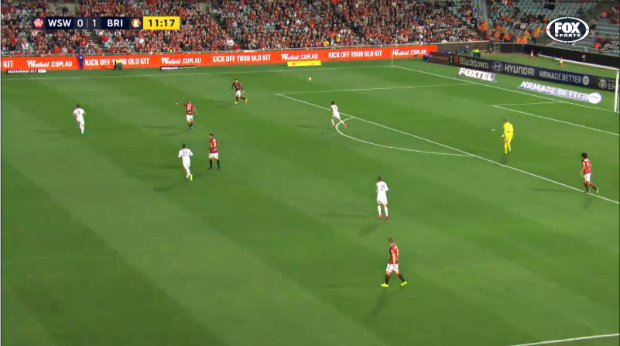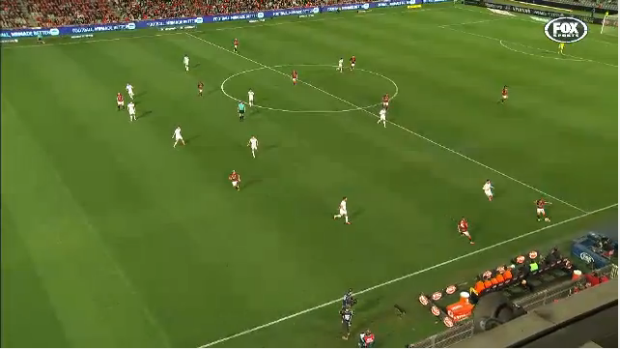Ultimately, the difference between the two sides was encapsulated by how effectively they defended from set-piece situations, with the Wanderers guilty of missing several key chances in prime positions.
Besides the concession of three avoidable goals, the most frustrating aspect of the Wanderers’ performance was how the side seemingly abandoned the approach they had paraded during pre-season.
This was evidenced in just the opening seconds of play where Dimas lofted a long ball over the top of the Roar defence from kick-off. Admittedly, this action is a stock-standard option taken by most teams as it allows the defensive shape of the team to be organized, and for the side to settle into a comfortable pattern without the ball.
But on this occasion it was symbolic of what would unravel later, with the team unable to build from the back as they had done so in previous matches. The Wanderers were too often subconsciously forced into a direct approach, and this, along with the inability to convert in front of goal, made them masters of their own downfall.
Brisbane nullify Dimas
With both teams eager to press high up the pitch, the early stages of the match saw a frenetic opening stanza that could have seen either side open their account before Jamie Maclaren’s 9th minute strike.
“We want to play possession with a purpose and win the ball back quickly when we lose it”, said John Aloisi before the game, perhaps issuing a rallying cry to his attacking quartet who had been guilty of standing off in the Westfield FFA Cup encounter between these two sides in August.
This was a feature of Aloisi’s game plan that proved vital in disrupting the Wanderers’ transition from defence to attack. Brisbane were able to stop the Wanderers at the source of danger: restricting Dimas’ ability to play the ball forward to feet by initiating spells of pressure in the Wanderers own third.

The tone was set early. Previously, we noted how Dimas has been dictating spells of possession by coming deep to receive the ball before capitalizing on the width of the fullbacks to play through the defensive lines.
But here, Brisbane were intelligent and industrious enough to prevent the Wanderers, and Dimas in particular, from playing through the middle by forcing play to one side.
This generated countless turnovers in possession from the Wanderers who were often forced into 50/50 balls up field and ultimately why they struggled to gain a foothold of possession in this game.

Brisbane’s front four worked tirelessly to force the Wanderers into long balls, which resulted in breakdown of possession.
Wanderers find joy down the left (again)
Although Brisbane’s high defensive line and pressing was key in tipping the balance of play in their favour, it was ironically their downfall for the Wanderers’ goal.
This is a moment from the game in which the Wanderers hierarchy will look upon with fondness, not only because it was a positive response after going behind but because of the clever way it was constructed.
After Dimas picked out Jamieson on the left, Mitch Nichols darted into the space behind the Brisbane defensive line. The ball from Jamieson was measured but the movement from Sotirio and Nichols was pivotal: the former drawing Roar fullback Jack Hingert up field whilst Roar midfielder Corona failed to track Nichol’s angled run.

The finish was sheer precision from the former Roar man who enjoyed a mostly productive night despite the team not functioning as well as it could have.
Although the Wanderers might have scored from several different areas from the pitch, it was no surprise that the goal arrived from the left hand side.
It’s the area of the field that the Wanderers create the most (9/14 key passes, 5/6 shots on target arrived from the left) and generally look more threatening, with Scott Jamieson and Jaushua Sotirio impressing again last night.




